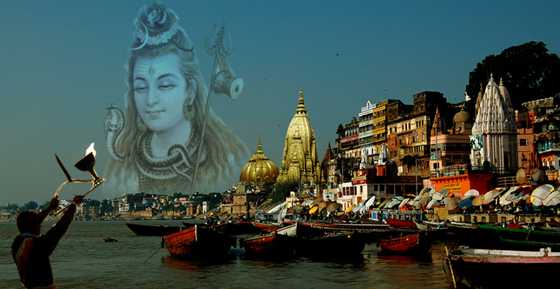No products in the cart.
Of all the gods in Hinduism, there is none that’s appealed to the emotions of a Hindu mind like Lord Shiva. Jyotirlingam represents one of the most divine forms of lord Shiva. Jyoti means ‘radiance’ and lingam the ‘mark or sign’. There is nothing to distinguish in its appearance; it symbolizes the formless nature of Shiva. But legend has it that a person can see these lingas as columns of fire piercing through the earth after he reaches a higher level of spiritual attainment.
According to Shiva puraanam, once Brahma and Vishnu had an argument over supremacy of creation. To test them, Shiva pierced the three worlds as a huge endless pillar of light, the jyotirlinga. Vishnu and Brahma split their ways to downwards and upwards respectively to find the end of the light in either direction. Brahma lied that he found out the end, while Vishnu conceded his defeat. Shiva appeared as a second pillar of light and cursed Brahma that he would have no place in ceremonies while Vishnu would be worshipped till the end of eternity. The jyothirlinga shrines thus are places where Shiva appeared as a fiery column of light.
These are 12 shrines were jyotirlingas are present in India. There are actually 64 but these 12 are considered to be the most auspicious ones.
The 12 divine Jyotirlingas:
- Somnath Temple
- Mallikarjun Temple
- Mahakaleshwara Temple
- Omkareshwar Temple
- Baidyanath Temple
- Bhimashankar Temple
- Rameshwaram Temple
- Nageshwar Temple
- Kashi Vishwanath Temple
- Trimbakeshwar Temple
- Kedarnath Temple
- Grishneshwar Temple
Right in the heart of the gangetic plains the beautiful holy city of Varanasi was built. Enshrined in the kasha vishwanatha temple is the jyotirlinga of Shiva known as vishweshvara or vishwanatha.
It is also known as kasha due to the kasha tribes that inhabited that region. Today it is most visited pilgrimage spot for Hindus all over the world. A simple glimpse of the Jyotirlinga is a rejuvenating experience that transforms life and takes us closer to the divine almighty. There is an added advantage to the pilgrims of Varanasi. A visit to all the other shrines of jyotirlingas across the country equals one visit to the kasha vishwanatha temple which is considered the superior of all.
Kashi is the eternal destination for moksha and salvation. It is believed that people who die in kasha are free from the cycle of birth. Kashi is also known as avimukta kshetra. Brahma was ordered by Shiva to create a world, and on his command Brahma created this wonderful world. It had fifty crore Yojanas of area and fourteen lokas. In order to save the lives of these who are bound by their own actions or karma. Shiva kept kashi city away from the entire universe. In this city, Shiva Himself established the savior Muktidayak JyotirLinga, which He can never leave. Shiva removed this very Kashi from His Trident and set it in this mortal world. It was not to be destroyed when Brahma’s day ends, but during Pralay, which is the final destruction by nature herself. But Shiva saved it by keeping it safe in his trident. So the kashi is called avimukta kshetra.
Kashi Vishwanath Temple
The place is a culmination rich Indian traditions, history and lush natural resources. Varanasi is also visited by scores of foreigners. Not long ago, the temple also witnessed a series of invasions that is the reason why the temple has been rebuilt several times. he Kashi Vishweshwar temple as we see it now was built by Ahalya Devi Holkar in 1777 AD. In 1785 AD, the then King of Kashi, Mansaram and his son Belvant Singh built many more temples near Varanasi. In 1755 AD, the Avadh pant of pratinidhi got the old temple of Bindumadhava repaired and renovated it beautifully. The kalabhairava temple was built by Srimant Baji Rao Peshwa in 1852 AD. Beside its religious significance; the temple is also an architectural spectacle. The summit of Hindu culture is quite the breathtaking view due to generous rulers and patrons as mentioned before. The Kashi Vishwanath Temple is also popularly known as the ′Golden Temple′ due the gold plating done on the towers.
King Ranjit Singh had the Kashi Vishwanath temple towers covered in gold it is said that more than one tonne of gold was used for this purpose. A monumental bell hangs in the temple. It was donated by the King of Nepal. Similar to the rameshwaram temple, the kasha vishwanathar temple also has theerthams and wells in which devotees throng to take a holy bath. One of the most important wells is called as jnana vapi which literally translates to wisdom well.
“The Lord is so kind that He has spread the river Ganges throughout the universe so that by taking bath in that holy river everyone can get released from the reactions of sins, which occur at every step”
Srimad Bhagavatam 3.5.41
The ganga is the nectar that fills the earth of the kasha vishwanathar temple. Ganga is considered the holiest of all rivers despite the high levels of pollution it suffers from today. Thousands of Hindus undertake a journey to Varanasi on any normal day. All for one dip that is going to purify them of all their sins and liberate them from birth. As human beings we all have a tendency to sin. Purifying oneself in ganga is considered to be the way of feeling remorseful for one’s actions. The ability to identify our faults and regretting them is what takes us close to god and that is exactly what ganga signifies. It is not just the power of ganga that removes us of all sins but your mind flashing your entire life in those minutes underwater when one comes out of the water after the holy dip, winds of change are sure to blow.






